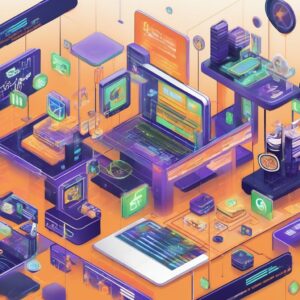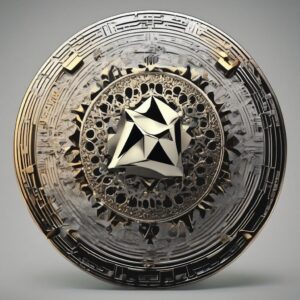Or try one of the following: 詹姆斯.com, adult swim, Afterdawn, Ajaxian, Andy Budd, Ask a Ninja, AtomEnabled.org, BBC News, BBC Arabic, BBC China, BBC Russia, Brent Simmons, Channel Frederator, CNN, Digg, Diggnation, Flickr, Google News, Google Video, Harvard Law, Hebrew Language, InfoWorld, iTunes, Japanese Language, Korean Language, mir.aculo.us, Movie Trailers, Newspond, Nick Bradbury, OK/Cancel, OS News, Phil Ringnalda, Photoshop Videocast, reddit, Romanian Language, Russian Language, Ryan Parman, Traditional Chinese Language, Technorati, Tim Bray, TUAW, TVgasm, UNEASYsilence, Web 2.0 Show, Windows Vista Blog, XKCD, Yahoo! News, You Tube, Zeldman
HackPostMedia
Best in TechnologyCryptocurrency Apps: Navigating the Digital Currency Landscape 11 Mar 2024, 8:56 am
As the digital era ushers in a revolution in how we view and handle money, cryptocurrency stands at the forefront of financial technology innovation. With the rapidly growing interest in digital currencies like Bitcoin, Ethereum, and countless others, the market has seen an influx of cryptocurrency apps designed to facilitate the buying, selling, trading, and management of these assets. This article delves into the world of cryptocurrency apps, covering how they work, the features they offer, and the considerations one should take into account when using them.

Understanding Cryptocurrency Apps
Cryptocurrency app are mobile or web-based applications that allow individuals to manage their digital currencies. These apps can range from wallets (for storing digital assets) to exchanges (for trading digital assets) and portfolio trackers (for monitoring investments).
Types of Cryptocurrency Apps
- Wallet Apps: These apps store the public and private keys required to conduct cryptocurrency transactions. Wallets can be “hot” (online and connected to the Internet) or “cold” (offline storage options like hardware wallets). Examples include Trust Wallet and Ledger Live.
- Exchange Apps: They provide a platform for buying, selling, and trading cryptocurrencies. Some offer a wide range of cryptocurrencies, while others might specialize in a few. Prominent examples include Binance, Coinbase, and Kraken.
- Portfolio Trackers: These apps help users track their cryptocurrency investments, showing real-time values, profits, losses, and trends. Examples include Blockfolio and Delta.
- News and Analysis Apps: To navigate the volatile cryptocurrency market, staying informed is key. These apps offer news, market analysis, and insights into cryptocurrency trends. CoinDesk and CryptoPanic are popular options.

Key Features of Cryptocurrency App
- Security Measures: Top apps offer robust security features like two-factor authentication (2FA), encryption, and multi-signatory accounts.
- User Interface: A clean, intuitive interface is essential for user experience, particularly for beginners.
- Transaction Fees: Understanding the fee structure is crucial, as fees can vary widely among apps.
- Supported Currencies: While some apps support a wide range of digital currencies, others might be limited. Choose based on your needs.
- Customer Support: Good customer service is vital, especially in a market as complex as cryptocurrency.

Considerations When Using Cryptocurrency Apps
- Security: Despite the convenience of hot wallets, cold wallets provide superior security for storing large amounts of digital currency.
- Regulatory Environment: The regulatory stance on cryptocurrencies can vary by country. It’s essential to use apps that comply with your country’s regulations.
- Privacy: Some apps may require more personal information than others. Consider your privacy preferences before signing up.
- Backup and Recovery: Ensure that any wallet app used has a clear backup and recovery process to safeguard against accidental loss.
Future of Cryptocurrency Apps
The future of cryptocurrency app appears promising, with innovations continually emerging. Decentralized finance (DeFi) apps, for example, are expanding the possibilities within the crypto space by offering decentralized lending, borrowing, and trading services. Furthermore, as cryptocurrency adoption grows, we may see more integrated services and even central bank digital currencies (CBDCs) being managed through consumer-friendly apps.

Conclusion
Cryptocurrency app are the gateways to engaging with digital currencies, providing tools for secure storage, trading, investment tracking, and staying informed. As the market continues to evolve, so too will the features and capabilities of these apps. Whether you’re a seasoned investor or new to the cryptocurrency world, understanding and selecting the right app can significantly impact your digital currency experience. Always prioritize security, user-friendliness, and compliance with local regulations in your choice of cryptocurrency app, and be prepared to adapt as the digital currency landscape continues to develop.
The post Cryptocurrency Apps: Navigating the Digital Currency Landscape appeared first on HackPostMedia.
Cryptocurrency Trading: Navigating the Halal and Haram 11 Mar 2024, 8:27 am
In recent years, cryptocurrency Trading Halal and Haram has emerged as a revolutionary form of digital currency, intriguing investors around the globe with its potential for high returns. However, for Muslims, investments are not merely financial decisions. They also involve ethical and religious considerations to ensure that their financial actions remain in harmony with Islamic principles. This has led to a significant debate among scholars and practitioners alike regarding whether trading in cryptocurrencies aligns with Islamic law (Sharia). This article delves into the nuanced perspectives surrounding the halality (permissibility) and haramity (prohibition) of cryptocurrency trading in Islam.
Understanding Islamic Finance Principles
Before exploring cryptocurrencies, it’s crucial to establish the basic principles of Islamic finance. Islamic finance is governed by Sharia, which prohibits usury (riba), uncertainty (gharar), gambling (maysir), and investments in businesses that deal with alcohol, gambling, and other haraam (forbidden) activities. Any financial transaction or investment must comply with these principles to be considered halal (permissible).

Cryptocurrency and Its Compatibility with Sharia
The debate around the halality of cryptocurrency trading revolves around several core issues:
1. Riba (Usury):
Cryptocurrency, by itself, doesn’t produce interest in the conventional sense and thus, doesn’t directly violate the prohibition of riba. However, certain practices in cryptocurrency Trading Halal and Haram, like earning interest on crypto deposits, could be considered riba and thus haram.
2. Gharar (Uncertainty):
Some scholars argue that the high volatility and unpredictability of cryptocurrency markets introduce excessive uncertainty, making trading in them akin to gambling and thus haram. Others, however, see this volatility as a normal market risk, similar to that in traditional stock markets, which can be mitigated with proper knowledge and strategies.
3. Investment in Prohibited Activities:
If a cryptocurrency Trading Halal and Haram is directly involved in or finances haram activities, investing in it would undoubtedly be haram. However, most cryptocurrencies, like Bitcoin or Ethereum, are platforms or mediums of exchange and don’t inherently engage in haram activities.
4. Zakah (Almsgiving):
Cryptocurrencies can be subjected to Zakah, like any other form of wealth, if they meet the nisab (minimum amount of wealth) and hawl (holding period). This aspect aligns with Islamic principles of wealth distribution and charity.
Scholarly Perspectives and Fatwas
The scholar’s perspectives on cryptocurrencies vary widely. Some scholars in countries like Egypt have declared Bitcoin trading haram due to its speculative nature and potential for misuse. Conversely, other scholars and Islamic finance experts have issued fatwas declaring cryptocurrency trading halal, provided it adheres to Islamic finance principles, avoiding riba, gharar, and investments in haram activities.
Significant is the certification of some cryptocurrencies as “Sharia-compliant” by certain Islamic scholars and financial bodies, focusing on their use as currency rather than speculative assets and ensuring they don’t violate any Islamic finance principles.

NFTs, Futures Trading, and FAQs in Islamic Finance
The intersection of Islamic finance and rapidly evolving digital assets, including Non-Fungible Tokens (NFTs), futures trading, and other modern financial instruments, presents both opportunities and challenges for Muslim investors. This article aims to shed light on these aspects, guided by Islamic principles, and seeks to address frequently asked questions regarding their permissibility.
Non-Fungible Tokens (NFTs) from an Islamic Perspective
NFTs represent ownership or proof of authenticity of unique digital items using blockchain technology. Unlike cryptocurrencies, which are fungible, meaning each unit is the same as every other unit, NFTs are unique.
Halal or Haram?
- Content: The content of NFTs plays a significant role in determining their permissibility. NFTs representing ownership of haram content (e.g., images not in line with Islamic modesty, music prohibited by certain interpretations, etc.) are clearly haram.
- Speculation and Gharar: High speculation and the potential for significant price manipulation in the NFT market raise concerns about gharar. If the purchase or sale of NFTs is made purely for speculative purposes, it might fall into prohibited territory.
- Utility and Value: NFTs with clear utility or those that represent a digital asset of intrinsic value (e.g., digital real estate, patents) may be considered halal, especially if they encourage creativity and support Islamic art and culture without engaging in speculation.

Futures Trading in Light of Islamic Law
Futures trading involves a contractual agreement to buy or sell a particular commodity or financial instrument at a predetermined future date and price. Islamic finance principles have specific considerations regarding such contracts.
Halal or Haram?
- Gharar (Uncertainty) and Maysir (Gambling): Futures contracts often involve elements of uncertainty and speculation, deemed gharar, and can resemble gambling (maysir), which is strictly prohibited.
- Riba (Interest): Futures trading can also entail interest, particularly if the contracts are extended. Any form of riba is clear-cut haram.
- Halal Alternatives: Islamic finance offers alternatives like Salam contracts and Istisna’a contracts, which are types of forward contracts designed to comply with Sharia law. These contracts necessitate specific conditions, like full upfront payment in Salam contracts, to avoid the pitfalls of gharar and riba.
Frequently Asked Questions (FAQs)
1. How can I ensure my investments in digital assets are halal?
- Seek knowledge and conduct thorough research.
- Consult with scholars and experts in Islamic finance.
- Look for Islamic financial institutions or advisory firms offering Sharia-compliant investment options.
2. Are there any Sharia-compliant NFTs or cryptocurrency projects?
- Yes, there are projects aimed at being Sharia-compliant by ensuring the products or services offered are halal and by minimizing speculation. It’s important to research these projects thoroughly and consult with knowledgeable sources.
3. Can futures trading ever be considered halal?
- Traditional futures trading, as practiced in most financial markets, is generally considered haram due to gharar, maysir, and riba. However, Islamic finance provides alternatives like Salam and Istisna’a contracts, which, if structured correctly, can offer Sharia-compliant ways to achieve similar ends.
4. Will investing in digital assets affect my obligation to pay Zakat?
- Yes, owning digital assets like cryptocurrencies or NFTs can affect your Zakat obligations if the assets reach the nisab and you hold them for one lunar year.

Conclusion
The hilality of cryptocurrency trading in Islam remains a subject of debate, and the diversity in scholarly opinions reflects the nascent and evolving nature of the cryptocurrency market itself. For Muslims considering investing in cryptocurrencies, the key is to conduct thorough research, seek knowledge from trusted Islamic finance experts, and critically assess how their investment choices align with Islamic ethical and legal principles. As the market and the understanding of cryptocurrencies continue to evolve, so too will the Islamic scholarly perspectives on this intriguing form of digital asset.
The post Cryptocurrency Trading: Navigating the Halal and Haram appeared first on HackPostMedia.
The Evolution and Mechanics of Cryptocurrency Trading Platforms 11 Mar 2024, 8:04 am
Cryptocurrency has emerged as a groundbreaking financial technology, transforming the way we think about money and transactions. At its core, it is a digital or virtual currency that uses cryptography for secure financial transactions, decentralized control, and the creation and management of new units. The trading of cryptocurrencies takes place on platforms specifically designed for this purpose, known as cryptocurrency trading platforms.
What are Cryptocurrency Trading Platforms?
Cryptocurrency trading platforms are digital marketplaces where individuals can buy, sell, or exchange cryptocurrencies for other digital currency or traditional currency like US dollars or Euro. These platforms provide a medium for participating in the financial markets built around cryptocurrencies. They are the backbone of the crypto trading ecosystem, providing liquidity, security, and accessibility to traders and investors of all levels.

Types of Cryptocurrency Trading Platforms
- Centralized Exchanges (CEXs): Operated by a single organization that serves as the middleman for trading. They are known for high liquidity, user-friendly interfaces, and a wide range of services like spot trading, futures trading, and even staking. However, they are also seen as less secure due to their centralized nature, making them more vulnerable to hacking.
- Decentralized Exchanges (DEXs): These platforms operate without a central authority, facilitating direct peer-to-peer transactions. They enhance security and privacy but may suffer from lower liquidity and slower transaction speeds compared to CEXs.
- Hybrid Exchanges: Combining features of both CEXs and DEXs, hybrid exchanges aim to offer the best of both worlds – the liquidity and speed of CEXs with the security and anonymity of DEXs.

Key Features of Cryptocurrency Trading Platforms
- Security: Robust security measures including two-factor authentication, encryption, cold storage, and multi-signature wallets.
- Liquidity: High liquidity facilitates quicker and more accurate order fulfillment.
- User Interface: An intuitive and user-friendly interface is crucial for both beginners and experienced traders.
- Trading Pairs: A wide range of trading pairs increases opportunities for traders.
- Fees: Transparent fee structures without hidden costs are vital. Most platforms charge a combination of trading fees and withdrawal fees.
- Customer Support: Responsive and knowledgeable customer support is essential, especially for new traders.

How to Choose the Right Platform
- Research Reputation: Look into the platform’s history, user reviews, and any past security breaches.
- Assess Security Measures: Understanding the security protocols in place is crucial.
- Consider User Interface and Experience: Ensure the platform is easy to use and suits your trading needs.
- Evaluate Fee Structure: Be aware of all potential fees you may incur.
- Check for Regulatory Compliance: Platforms complying with regulations are often more reliable.
The Future of Cryptocurrency Trading Platforms
The future of cryptocurrency trading platforms looks promising, with ongoing advancements in technology, security, and regulatory frameworks. The rise of decentralized finance (DeFi) and ongoing innovation in blockchain technology are likely to lead to more secure, efficient, and inclusive trading platforms.
Decentralization, enhanced security measures, and user-focused features are anticipated to become standard across platforms. Moreover, increased regulatory clarity and compliance are expected to attract more institutional investors into the space, further boosting liquidity and market maturity.]

Conclusion
Cryptocurrency trading platforms are at the heart of the digital asset revolution, offering a bridge between traditional financial systems and the future of money. Whether you’re a seasoned trader or a newcomer to the cryptocurrency world, understanding the different types of exchanges, their features, and how to select the right one for your needs is crucial for navigating this dynamic market. As the sector continues to evolve, staying informed and agile will be key to success in the world of cryptocurrency trading.
The post The Evolution and Mechanics of Cryptocurrency Trading Platforms appeared first on HackPostMedia.
How Much Does a Tesla Cybertruck Cost in Pakistan? 7 Mar 2024, 12:07 am
The Tesla Cybertruck has been a highly anticipated electric pickup truck that promises cutting-edge technology, innovative design, and impressive performance. While Tesla is known for pushing the boundaries of automotive engineering, including electrification and autonomous driving, the Cybertruck stands out as a unique offering in the market. Let’s delve into the features of the Tesla Cybertruck and discuss its expected price in Pakistan.
Overview of the Tesla Cybertruck
The Tesla Cybertruck was unveiled in 2019, showcasing a futuristic and angular design made of ultra-hard 30X cold-rolled stainless-steel exoskeleton, creating a distinctive aesthetic that sets it apart from traditional pickup trucks. Key features of the Cybertruck include:
- Electric Powertrain: The Cybertruck is powered by Tesla’s electric drivetrain technology, promising impressive acceleration, towing capabilities, and long-range driving on a single charge.
- Performance: Tesla claims that the top-end Tri Motor All-Wheel Drive configuration can go from 0 to 60 mph in under 2.9 seconds, showcasing exceptional performance for a vehicle of its size and class.
- Towing and Payload Capacity: The Cybertruck is designed to be a workhorse, featuring a towing capacity of up to 14,000+ pounds and a payload capacity of up to 3,500+ pounds, making it suitable for both utility and recreational purposes.
- Autonomous Driving: The Cybertruck is expected to offer Tesla’s advanced Autopilot features and Full Self-Driving capabilities, providing enhanced safety, convenience, and automation for drivers.

Tesla Cybertruck Price in Pakistan
As of now, Tesla has not officially launched the Cybertruck for sale, and pricing details in Pakistan remain speculative. However, based on international pricing, the expected starting price of the Cybertruck could range from $39,900 for the single-motor rear-wheel-drive version to over $69,900 for the triple-motor all-wheel-drive variant with extra features.
When considering the import and customs duties, potential taxes, and additional costs associated with bringing a Tesla vehicle to Pakistan, the final price for the Cybertruck could vary significantly. It’s advisable to consult with local Tesla representatives or authorized dealers in Pakistan for the most accurate pricing information and details regarding availability.
Tesla Cybertruck Features and Performance
The Tesla Cybertruck, known for its unique design and innovative features, promises exceptional performance that sets it apart from traditional pickup trucks. Let’s delve into the performance aspects of the Cybertruck:
Acceleration and Speed
- Quick Acceleration: The Tesla Cybertruck offers impressive acceleration across its range of configurations. The top-end Tri Motor All-Wheel Drive variant boasts a claimed 0-60 mph acceleration time of under 2.9 seconds, placing it in the realm of high-performance sports cars rather than typical pickup trucks.
- Top Speed: While pickup trucks are not typically associated with high speeds, the Cybertruck’s electric powertrain enables it to achieve remarkable top speeds. The exact top speed can vary based on the configuration but is likely to be electronically limited for safety reasons.
Towing and Payload Capacity
- Towing Capacity: One of the standout features of the Cybertruck is its exceptional towing capacity, with the ability to tow over 14,000 pounds in some configurations. This makes it well-suited for towing trailers, boats, and other heavy loads.
- Payload Capacity: In addition to its towing capabilities, the Cybertruck offers a remarkable payload capacity of over 3,500 pounds, providing ample room for cargo and equipment in its spacious truck bed.
Range and Efficiency
- Range: Tesla has a reputation for producing electric vehicles with impressive driving ranges, and the Cybertruck is no exception. With different battery options available, the Cybertruck is expected to offer ranges that cater to the needs of various drivers, from daily commuters to long-distance travelers.
- Efficiency: Electric vehicles are known for their efficiency compared to traditional gasoline counterparts. The Cybertruck’s efficient electric drivetrain and battery technology ensure that drivers can cover significant distances on a single charge, reducing the need for frequent recharging.
Off-Road Capability
- All-Wheel Drive Performance: The Cybertruck’s All-Wheel Drive configuration provides enhanced traction and stability, making it well-suited for off-road driving, challenging terrain, and adverse weather conditions.
- Ground Clearance: The Cybertruck offers ample ground clearance, allowing it to navigate rough terrain and obstacles with ease. This feature enhances its off-road capability and versatility as an adventure vehicle.

Autonomous Driving Features
- Autopilot: Tesla vehicles, including the Cybertruck, come equipped with advanced Autopilot features that provide semi-autonomous driving capabilities, enhancing safety, convenience, and reducing driver fatigue during long journeys.
- Full Self-Driving (FSD): With Tesla’s Full Self-Driving option, the Cybertruck can potentially offer advanced autonomous driving features, such as automatic lane changes, parking assistance, and navigating city streets, further enhancing its performance and user experience.
Conclusion
The Tesla Cybertruck represents a paradigm shift in the pickup truck market, blending advanced electric technology, robust performance, and futuristic design in a single package. While the exact pricing and availability in Pakistan may still be uncertain, the Cybertruck’s arrival is eagerly anticipated by enthusiasts and those seeking a bold and sustainable alternative in the automotive industry. Keep an eye on official announcements from Tesla regarding the Cybertruck’s launch in Pakistan for updated pricing and availability details.
The post How Much Does a Tesla Cybertruck Cost in Pakistan? appeared first on HackPostMedia.
The Samsung S24 Ultra: What You Need to Know 6 Mar 2024, 11:45 pm
The Samsung S24 Ultra is one of the most highly anticipated flagship smartphones from Samsung, expected to showcase cutting-edge technology and features. While exact details may vary until an official announcement, we can anticipate the S24 Ultra to embody the premium design, superior performance, and innovative features that Samsung’s Ultra series is known for.The Samsung Galaxy S24 Ultra price is expected to be a flagship smartphone offering a range of cutting-edge features and specifications. Here are some key aspects commonly associated with Samsung’s Ultra series phones:
Key Features of Samsung S24 Ultra
- Display: The Samsung S24 Ultra is expected to feature a stunning display, potentially using an advanced AMOLED panel with high resolution, vibrant colors, and high refresh rates for smooth visuals. The display size is likely to be generous, providing an immersive viewing experience for multimedia and gaming.
- Performance: Powered by a top-tier chipset (potentially from Samsung’s Exynos series or Qualcomm Snapdragon), the S24 Ultra is expected to offer exceptional performance levels for multitasking, gaming, and intensive applications. Along with ample RAM and internal storage options, users can expect seamless navigation and high responsiveness.
- Camera: Samsung is renowned for its exceptional camera technology, and the S24 Ultra is anticipated to continue this trend. The smartphone is expected to boast a versatile camera setup, potentially including multiple high-resolution sensors, advanced optical zoom capabilities, enhanced image processing features, and cutting-edge AI enhancements for photography and videography.
- Battery: With the S24 Ultra, Samsung is likely to prioritize battery life, equipping the device with a sizable battery capacity and efficient power management features. Users can expect extended usage on a single charge, supported by fast charging and wireless charging capabilities.
- Design: Samsung’s flagship devices are known for their premium design aesthetics, cutting-edge materials, and sleek form factors. The S24 Ultra is anticipated to feature a sophisticated design with slim bezels, a curved display, and top-notch build quality, reflecting Samsung’s commitment to aesthetics and functionality.
- Software: The smartphone is expected to run on Samsung’s One UI interface, based on the latest version of Android. Samsung typically integrates numerous software features and optimizations to enhance user experience, offering customization options, productivity tools, and seamless integration with Samsung’s ecosystem of services.

Expected Innovations and Additional Features
- 5G Connectivity: The S24 Ultra is expected to offer 5G compatibility for high-speed connectivity and low latency.
- Improved Biometric Security: Advanced security features such as under-display fingerprint sensors and facial recognition technology enhance user privacy and data protection.
- Enhanced Audio: Samsung’s Ultra series often includes premium audio features such as stereo speakers, support for hi-res audio formats, and AI-powered audio optimizations.
- S Pen Support: The S24 Ultra might offer compatibility with Samsung’s S Pen stylus, providing additional functionality for note-taking, drawing, and creative tasks.
- Display: The S24 Ultra is likely to feature a high-quality display, possibly an AMOLED panel with a high refresh rate for smooth visuals and vibrant colors.
- Camera: Samsung’s Ultra phones are known for their advanced camera setups, potentially including multiple high-resolution sensors, sophisticated optical zoom capabilities, and advanced image processing features.
- Performance: Powered by a top-of-the-line chipset, ample RAM, and internal storage, the S24 Ultra is expected to deliver exceptional performance for multitasking, gaming, and productivity.
- Battery: A large battery capacity coupled with efficient power management features ensures extended usage without frequent recharges.
- Design: Samsung’s Ultra smartphones often feature premium build materials, sleek designs, and innovative form factors, including slim bezels and curved displays.
Comparison with iPhone 15 Pro Max
When comparing the Samsung Galaxy S24 Ultra to the iPhone 15 Pro Max, several factors should be considered:
- Operating System: The Samsung Galaxy S24 Ultra price runs on the Android operating system, while the iPhone 15 Pro Max runs on iOS. The choice between the two often comes down to personal preference.
- Display: Both phones are expected to offer high-quality displays, but Samsung’s AMOLED panels are known for vibrant colors and deep blacks, while Apple’s Retina displays are praised for color accuracy and brightness.
- Camera: Both smartphones are likely to feature advanced camera systems; Samsung’s emphasis is often on versatility and advanced features, while Apple focuses on computational photography and video capabilities.
- Performance: The choice between Samsung and Apple often depends on your preference for the Android or iOS ecosystem, as both phones are expected to offer top-tier performance.
- Price: Samsung and Apple devices typically differ in pricing, with Samsung often offering competitive prices for the features included, while Apple devices tend to be positioned at the premium end of the market.

Conclusion
The Samsung S24 Ultra price is anticipated to be a flagship device that pushes the boundaries of smartphone technology, offering premium features, top-notch performance, and innovative capabilities. While specific details will be unveiled upon the official launch, the S24 Ultra price is expected to uphold Samsung’s tradition of excellence and innovation in the smartphone market, catering to users seeking a premium experience and cutting-edge technology in their mobile devices.
The post The Samsung S24 Ultra: What You Need to Know appeared first on HackPostMedia.
Unraveling Ethereum Blockchain: A Comparative Analysis with Bitcoin 6 Mar 2024, 11:23 pm
In the burgeoning world of cryptocurrencies, Ethereum and Bitcoin stand as two of the most prominent and influential players. While Bitcoin introduced the world to decentralized digital currency, Ethereum has expanded on Bitcoin’s foundational blockchain technology to offer additional functionalities, most notably smart contracts. This detailed article explores the Ethereum blockchain, its unique features, and how it compares to Bitcoin.
Introduction to Ethereum
Ethereum was proposed in late 2013 by programmer Vitalik Buterin and development was crowdfunded in 2014, with the network going live on July 30, 2015. It is an open-source, blockchain-based platform that enables developers to build and deploy decentralized applications (dApps) and smart contracts. Unlike Bitcoin, which was created primarily as an alternative to traditional currencies, Ethereum is designed to be a programmable blockchain that can facilitate complex agreements and automated transactions without the need for intermediaries.

Core Features of Ethereum
Smart Contracts
Smart contracts are self-executing contracts with the terms of the agreement directly written into code. They automatically enforce and execute the terms of a contract when predetermined conditions are met. This technology is the backbone of Ethereum, enabling the creation of decentralized applications.
Ethereum Virtual Machine (EVM)
The EVM is the runtime environment for smart contracts in Ethereum. It provides a layer of abstraction between the executing code and the executing machine, enabling the code to run on any machine, making Ethereum’s applications more powerful and flexible.
Decentralized Applications (dApps)
Ethereum enables developers to build dApps on its blockchain. These applications operate autonomously without any central authority, enhancing transparency and reducing the risk of censorship or control by a single entity.
Ether (ETH)
Ether is the native cryptocurrency of the Ethereum platform. It is used as fuel to perform operations on the Ethereum network, such as executing smart contracts and dApps. This mechanism prevents spam on the network and allocates resources proportionally to the incentive offered by the request.
Ethereum vs. Bitcoin: A Comparative Analysis
Purpose and Application
Bitcoin was created as a digital alternative to traditional currencies, aiming to enable peer-to-peer transactions without the need for a central authority. Ethereum, however, was developed as a platform to facilitate immutable, programmatic contracts, and applications via its own currency.
Blockchain Technology
Both Ethereum and Bitcoin utilize blockchain technology, but they employ it in different ways. Bitcoin’s blockchain is primarily a ledger of transactions, while Ethereum’s blockchain is a more complex platform designed to run programming code for any decentralized application.

Consensus Mechanism
Initially, both Ethereum and Bitcoin used the Proof of Work (PoW) consensus mechanism, requiring miners to solve complex mathematical problems to validate transactions and create new blocks. However, Ethereum is in the process of transitioning to Proof of Stake (PoS) with its Ethereum 2.0 upgrade, which aims to reduce energy consumption and increase transaction speed.
Transaction Speed and Capacity
Ethereum’s block time (the time to validate a block of transactions) is significantly shorter than Bitcoin’s, resulting in faster transaction speeds. Furthermore, the introduction of Ethereum 2.0 aims to further increase its capacity for transactions through sharding, a process that will increase the number of transactions the network can process at any given time.
Flexibility and Capabilities
The most significant difference comes down to capabilities. Ethereum’s capability to host smart contracts and dApps provides a broader range of uses beyond financial transactions, from gaming and gambling to logistics and legal contracts.
The Future of Ethereum and Bitcoin
Ethereum and Bitcoin continue to evolve. Ethereum’s transition to PoS through Ethereum 2.0 is expected to address many of its scalability and environmental concerns. Meanwhile, Bitcoin remains the primary choice for investors looking for a digital store of value, akin to gold.
In conclusion, while Bitcoin and Ethereum are built on the foundation of blockchain technology, their purposes, applications, and technological implementations set them apart. Ethereum’s introduction of smart contracts and dApps has opened up a myriad of possibilities beyond mere transactions — creating a world where decentralized finance (DeFi), non-fungible tokens (NFTs), and more, thrive on its platform. As both networks continue to evolve, the broader impact on finance, governance, and society remains a fascinating area for future exploration.

Here’s a detailed overview of the Ethereum blockchain, focusing on its technology, architecture, and key components:
Overview of the Ethereum Blockchain
The Ethereum blockchain is a decentralized platform that enables developers to create and deploy smart contracts and decentralized applications (dApps). Ethereum goes beyond simple monetary transactions, offering a programmable blockchain that allows for a wide variety of applications to be built on top of its network.
Key Components of the Ethereum Blockchain
- Ethereum Virtual Machine (EVM): The EVM is the runtime environment for smart contracts in Ethereum. It executes smart contracts written in Ethereum’s programming language, Solidity, and ensures that code is executed precisely as programmed without downtime, fraud, or third-party interference.
- Gas: Gas is the unit that measures the computational effort required to execute operations or transactions on the Ethereum network. Gas cost varies based on the complexity of the operation or contract execution, incentivizing efficient use of the network.
- Ether (ETH): Ether is Ethereum’s native cryptocurrency, used to pay for transaction fees and computational services on the network. It also serves as a store of value and can be traded on exchanges like any other cryptocurrency.
- Smart Contracts: Smart contracts are self-executing contracts with the terms coded into the contract itself. They automatically enforce and execute the terms of an agreement, removing the need for intermediaries and ensuring agreements are securely maintained.
- Decentralized Applications (dApps): dApps are applications that run on a decentralized network rather than a centralized server. They use the Ethereum blockchain for data storage and execution. Popular dApps include decentralized finance (DeFi) platforms, gaming applications, and various other utility and governance projects.
Consensus Mechanism
Ethereum currently operates on a Proof of Work (PoW) consensus mechanism, similar to Bitcoin. However, Ethereum is in the process of transitioning to Proof of Stake (PoS) with the Ethereum 2.0 upgrade. PoS is expected to increase scalability, reduce energy consumption, and improve the overall efficiency and security of the network.
Use Cases of the Ethereum Blockchain
- Decentralized Finance (DeFi): Ethereum is a hub for DeFi applications, offering services such as lending, borrowing, decentralized exchanges, and yield farming.
- Non-Fungible Tokens (NFTs): Ethereum’s flexibility allows for the creation and trading of NFTs, unique digital assets that represent ownership of digital or physical assets.
- Supply Chain Management: Ethereum’s smart contracts can be used to trace and verify the authenticity of products through the entire supply chain.
- Gaming: Ethereum is used for developing blockchain-based games that integrate cryptocurrencies and digital assets into gameplay.
Conclusion
The Ethereum blockchain has revolutionized the concept of blockchain technology by introducing smart contracts and dApps, offering a versatile platform for developers to create a wide range of applications. Its upcoming transition to Proof of Stake through Ethereum 2.0 promises to address scalability and energy consumption issues, further cementing Ethereum’s role as a leading blockchain platform for innovation and decentralized applications.
The post Unraveling Ethereum Blockchain: A Comparative Analysis with Bitcoin appeared first on HackPostMedia.
Cardano Coin Price: What’s Driving the Market? 6 Mar 2024, 11:04 pm
As of the time of writing, I’m unable to provide real-time or current data, including the latest prices or financial market trends. However, I can offer a detailed overview of Cardano and factors that influence its coin price, which can be a valuable guide for understanding how cryptocurrencies like Cardano fluctuate in value.
Introduction to Cardano
Cardano is a blockchain platform built on a proof-of-stake consensus protocol called Ouroboros, which is designed to be more energy-efficient compared to the proof-of-work protocol used by Bitcoin. It was created by Ethereum co-founder Charles Hoskinson and developed by IOHK (Input Output Hong Kong). Unlike many other blockchain projects, Cardano distinguishes itself through a strong commitment to scientific research and peer-reviewed academic papers to ensure its blockchain is both secure and scalable.

Cardano’s Native Cryptocurrency: ADA
The native cryptocurrency of the Cardano blockchain is called ADA, named after the 19th-century mathematician Ada Lovelace, who is often regarded as the world’s first computer programmer. ADA is used to facilitate transactions on the Cardano network, participate in the network’s governance through staking and voting, and pay for transaction fees.
Factors Influencing ADA’s Price
- Technology and Development Updates The release of new features, successful upgrades, and overall technological advancements within the Cardano ecosystem can positively affect ADA’s price. For example, the launch of smart contract functionality or improvements in scalability and transaction speed can draw increased user adoption and investment.
- Market Sentiment Cryptocurrency markets are highly influenced by trader sentiment, which can be swayed by news, social media, and overall industry trends. Positive news about Cardano or endorsements from influential figures can lead to price surges, while negative news can lead to declines.
- Regulatory News Announcements related to cryptocurrency regulation in major markets can impact ADA’s price. Regulatory clarity or positive legal developments can boost confidence, while threats of strict regulation or bans can have the opposite effect.
- Adoption and Partnerships Increased adoption of the Cardano blockchain for real-world applications and partnerships with reputable institutions or companies can lend credibility and increase demand for ADA.
- Market Conditions Broader market trends in the cryptocurrency space and global economic factors can influence ADA’s price. For instance, a bull market in cryptocurrencies generally lifts the prices of most coins, including ADA, while a bear market can lead to widespread losses.

Understanding Cardano’s Price Movements
Cardano has been subject to significant volatility, a common characteristic of the cryptocurrency market. Its price has seen dramatic rises and falls, reflecting the speculative nature of investors, technological advancements within the platform, and the shifting landscape of cryptocurrency regulation and adoption.
Future Outlook
The outlook for Cardano and ADA largely depends on several factors, including its technological development trajectory, how it competes with other blockchains, regulatory developments, and shifts in market sentiment. If Cardano coin price continues to achieve its roadmap goals and increases adoption, there could be positive price action for ADA. However, as with all cryptocurrencies, potential investors should proceed with caution and conduct thorough research, considering the market’s inherent volatility and risks.
FAQs
When it comes to cryptocurrency projects like Cardano, FAQs play a crucial role in educating and engaging the community, investors, and users. Given the complexity and the fast-evolving nature of blockchain technology, having a well-structured FAQ can help demystify aspects of the project and encourage broader participation and investment.
Importance of FAQs for Cryptocurrency Projects like Cardano
- Educational Resource: Cryptocurrency and blockchain technology come with a steep learning curve. FAQs serve as an entry point for newcomers to understand the basics of Cardano coin price, such as how to buy, store, and use ADA, Cardano’s native cryptocurrency, and the principles behind the Ouroboros proof-of-stake consensus mechanism.
- Transparency: By addressing common queries, Cardano’s project can demonstrate its commitment to transparency, providing clear information about the project’s goals, roadmap, governance model, and technological advancements.
- Community Support: A comprehensive FAQ can alleviate the workload on customer support and community managers by providing readily available answers to common questions, allowing them to focus on more complex inquiries.
- Trust Building: Clear and informative FAQs help build trust within the community. They show that the project leaders anticipate and care about the community’s concerns and questions, fostering a positive relationship between the project and its stakeholders.

Potential Topics Covered in Cardano’s FAQs
Given Cardano’s multi-faceted project scope, its FAQs could cover a broad range of topics, including but not limited to:
- Getting Started with Cardano and ADA: Information on how to buy ADA, recommended wallets for storing ADA, and how to safely manage and transfer ADA.
- Technical Details: Explaining Cardano’s blockchain architecture, including its layers, consensus mechanism, and the role of smart contracts on the platform.
- Staking and Governance: Details on how ADA holders can participate in staking, what staking involves, the rewards system, and how governance proposals are made and voted on.
- Development and Contributions: Guidance for developers interested in building on Cardano, including information on available tools, resources, and communities.
- Roadmap and Future Plans: Insights into Cardano’s development phases (known as eras: Byron, Shelley, Goguen, Basho, and Voltaire), including current progress and future objectives.
- Security and Safety: Best practices for protecting one’s investments and avoiding scams and phishing attempts within the Cardano ecosystem.
- Regulatory Compliance: Information on how Cardano coin price complies with global regulatory standards, addressing concerns regarding legality and the use of cryptocurrencies in various jurisdictions.
Updating and Maintaining FAQs
For a project like Cardano, which is continually evolving, it’s critical that the FAQs are regularly updated to reflect the latest developments, technological upgrades, and community concerns. This may involve adding new questions, revising answers, or reorganizing the FAQ structure for better accessibility.
Conclusion
While ADA’s price can be influenced by a myriad of factors, the core appeal of Cardano lies in its scientific approach to blockchain development and the promise of creating a scalable, secure, and efficient platform. As the Cardano ecosystem continues to evolve and expand its applications, it will be interesting to see how these advancements impact ADA’s price and the broader cryptocurrency landscape.
Please remember, the information provided here does not constitute investment advice, and prices can fluctuate greatly in the volatile cryptocurrency market. Always do your own research (DYOR) before making any investment decisions.
The post Cardano Coin Price: What’s Driving the Market? appeared first on HackPostMedia.
Technology: A Definition for the Ages 6 Mar 2024, 10:31 pm
Technology surrounds us in nearly every facet of our daily lives. It’s so pervasive that we sometimes take for granted just how extensive and complex the technology landscape is. This blog post seeks to unpack the broad and often nebulous concept of technology, outlining its definition, history, types, impacts, and future directions.
What Is Technology?
At its core, technology refers to the application of knowledge for practical purposes. It encompasses the tools, systems, and processes that humans create and utilize to solve problems, enhance capabilities, and make life easier and more efficient. From the wheel and the plow to smartphones and artificial intelligence, technology spans a vast array of inventions and innovations that have shaped human history and evolution.

The Evolution of Technology
The history of technology is as old as humanity itself. Early humans used stone tools to make their lives easier, marking the beginning of technological invention. As societies evolved, so did their technologies. The discovery of fire, the invention of the wheel, and the development of writing systems were all pivotal moments in human history. The Industrial Revolution of the 18th and 19th centuries marked a significant turning point, leading to the rapid advancement of technologies, including steam engines, telegraphy, and electricity. The 20th and 21st centuries have seen an unprecedented pace of innovation in areas like computing, telecommunications, and biotechnology.
Types of Technology
Technology can be broadly categorized into several types, each encompassing a wide range of fields and applications:
- Information Technology (IT): This involves the use of computers, telecommunications, and software to store, process, and transmit information. IT is a driving force behind the digital age, impacting almost every aspect of modern life.
- Biotechnology: This technology applies to the use of living organisms or their systems to develop products or processes for specific uses, ranging from agricultural production to medical therapies.
- Nanotechnology: The manipulation of matter on an atomic or molecular scale. Nanotechnology has potential applications in materials science, medicine, and electronics.
- Renewable Energy Technology: Including solar, wind, hydro, and geothermal energy technologies, this category is focused on developing clean, sustainable sources of power to address climate change and resource depletion.
- Artificial Intelligence (AI) and Robotics: These technologies encompass the creation of machines or software capable of intelligent behavior, including learning, reasoning, and adapting.
The Impact of Technology
Technology has significantly impacted every aspect of human life, society, and the environment. On the one hand, it has made possible incredible advances in medicine, communication, education, and productivity, greatly improving our quality of life. On the other hand, it has raised concerns about privacy, security, technological unemployment, and environmental degradation.
Ethical Considerations and Future Directions
As technology continues to advance at a rapid pace, ethical considerations become increasingly important. Issues surrounding data privacy, surveillance, AI ethics, and environmental sustainability are prompting a reevaluation of how we develop and deploy technology. The future of technology is likely to be shaped by a delicate balance between innovation and regulation, as we strive to harness the benefits of technology while mitigating its risks.
In conclusion, technology is a dynamic and multifaceted concept that defies easy definition. It is both a testament to human ingenuity and a reflection of our values, challenges, and aspirations. As we look to the future, understanding the broad implications of technological advances will be crucial in navigating the complexities of the modern world and ensuring that technology continues to serve the betterment of all humanity.

Conclusion
In sum, the concept of technology encompasses a vast, interwoven fabric of tools, systems, and methodologies derived from the application of scientific knowledge for practical purposes. Technology’s evolution, from the simplest of tools in the hands of early humans to the complex and interconnected digital systems of the 21st century, underscores its profound influence on the progression of human civilization. Its impact spans the spectrum from groundbreaking improvements in healthcare, education, and communication to more contentious issues like environmental degradation and social inequality.
As we stand at the brink of potentially transformative advancements in fields like artificial intelligence, biotechnology, and renewable energy, the importance of thoughtful and ethical engagement with technology cannot be overstressed. The decisions we make today regarding how we develop, deploy, and govern technology will shape the future of our planet and the human experience for generations to come.
To responsibly navigate this future, it is crucial for society to foster a deep understanding of technology’s potential benefits and drawbacks. This involves not only continuous innovation and exploration but also inclusive dialogue among scientists, policymakers, industry leaders, and the public. By doing so, we can collectively ensure that technological advancements align with our most cherished values and work towards creating a more equitable, sustainable, and prosperous world for all.
In conclusion, while the realm of technology is vast and its consequences complex, its ultimate value lies in its capacity to enhance the human condition. As we move forward, embracing both the promise and challenges of technological innovation will be key to unlocking its fullest potential for good.
The post Technology: A Definition for the Ages appeared first on HackPostMedia.
What is Technology Ecosystem? 6 Mar 2024, 10:13 pm
Technology ecosystems are expansive, interdependent networks of entities that include hardware, software, services, and digital content. They are built around platforms or core technologies that serve as a foundation upon which various products, services, and systems are developed, integrated, and interact. The evolution of technology ecosystems reflects the dynamism and rapid innovation characteristic of the digital age. This article provides a comprehensive overview of technology ecosystem, highlighting their components, importance, and current trends shaping the future.

Components of Technology Ecosystem
- Core Technologies: These are the foundational elements around which ecosystems are built. They include operating systems (like Windows, iOS, Android), platforms (such as Amazon Web Services, Google Cloud Platform), and key technologies (e.g., blockchain, artificial intelligence).
- Devices and Hardware: This encompasses a wide range of physical components—from personal computers and smartphones to sensors and IoT (Internet of Things) devices—that connect to or operate within the ecosystem.
- Software and Applications: Software solutions and applications that run on or interact with the core technologies and hardware. They range from productivity tools and entertainment apps to complex enterprise systems.
- Services: Services including cloud storage, SaaS (Software as a Service) offerings, streaming platforms, and support services that facilitate the operation and use of technologies within the ecosystem.
- Content and Digital Assets: Content such as digital media, ebooks, games, and datasets, along with various forms of digital assets, including cryptocurrencies and NFTs (Non-Fungible Tokens), play a significant role in the value and utility of technology ecosystems.
- Interoperability Standards and Protocols: Standards and protocols enable different technologies and components within the ecosystem to communicate and work together, ensuring compatibility and efficiency.
Importance of Technology Ecosystem
- Innovation and Growth: Technology ecosystems drive innovation by fostering environments where developers, companies, and creators can build upon existing technologies, collaborate, and bring new ideas and products to market.
- User Experience: Ecosystems aim to provide seamless, integrated experiences for users, where different products and services work together effortlessly, enhancing usability and satisfaction.
- Economic Impact: They contribute significantly to economic growth, both through direct financial returns and by enabling new business models and markets.
- Competitive Advantage: For businesses, being part of a robust technology ecosystem can provide competitive advantages such as access to new technologies, markets, and collaboration opportunities.
Current Trends Shaping Technology Ecosystem
- AI and Machine Learning Integration: Artificial intelligence and machine learning are becoming central to technology ecosystems, providing smarter, more adaptive, and personalized experiences.
- Increased Focus on Security and Privacy: With cybersecurity threats on the rise, ecosystems are emphasizing secure data practices and privacy-enhancing technologies.
- The Rise of Edge Computing: Pushing processing closer to the edge of networks reduces latency and enhances performance for IoT devices and mobile applications.
- Sustainability Efforts: There’s a growing commitment to sustainability within ecosystems, focusing on energy-efficient technologies and the reduction of electronic waste.
- Cross-Platform Interoperability: Efforts to enhance interoperability between different ecosystems are increasing, aiming to provide users with more flexibility and choice.
Technology ecosystems are dynamic and multifaceted, reflecting the interplay between various technological advancements and their adoption across different domains. As they continue to evolve, understanding the mechanisms of growth and the forces shaping them is essential for businesses, developers, and consumers alike, offering insights into future trends and opportunities in the digital landscape.
The post What is Technology Ecosystem? appeared first on HackPostMedia.
Google Books: A Comprehensive Guide to Downloading Content 4 Mar 2024, 5:37 pm
In the digital age, books and resources have become more accessible than ever, thanks to services like Google Books. Google Books is a vast online repository that allows users to explore millions of books from libraries and publishers worldwide. However, downloading content from Google Books for offline reading can seem daunting for new users. This article aims to provide a comprehensive guide on how to navigate Google Books and download available content, ensuring an optimized and informative experience for all readers.

Understanding Google Books
Google Books operates as both a search engine for book content and a digital library. It offers several ways to interact with the material:
- Preview: Limited previews of books are available, giving readers a glimpse of the content before deciding to purchase or find it in a library.
- Full View: Some books are available in their entirety for reading online, especially those in the public domain or with permission from the copyright holder.
- Purchase: Google Books also directs users to vendors where they can buy the book.
How to Download Books from Google Books
Step 1: Accessing Google Books
- Start by navigating to the Google Books website using your preferred web browser.
- Use the search bar at the top to find the book you’re interested in. You can search by title, author, ISBN, or even specific topics.
Step 2: Choosing the Right Book
- Once you’ve made a search, you’ll see a list of results. Books available for download will be marked with a “Full View” tag. Click on the title of the book that interests you.
Step 3: Downloading the Book
- If the book is available for download (in full view), look for the “Download” button on the upper right side of the page.
- Click on the “Download PDF” or “Download ePub” option, depending on your reading preference.
- PDF is suitable for a wide range of devices but retains the original formatting, which might not be optimal for small screens.
- EPUB is more flexible and better for e-readers and mobile devices, as the text adjusts according to the screen size.
Step 4: Saving the Book
- Once you click the download option, your browser will either automatically start downloading the file or ask you where to save it. Choose a location that’s easy for you to remember.
Important Points to Remember
- Copyright Restrictions: Not every book available on Google Books can be downloaded. Copyright laws protect many books, allowing only a preview or directing you to purchasing options.
- Internet Archive: For books in the public domain or with generous copyright permissions, you might also find downloadable copies in the Internet Archive, which Google Books sometimes links to.
- Software Requirements: Ensure your device has compatible software to read PDF or EPUB files. Many free e-reader apps and software are available for all platforms.
Conclusion
Google Books is an incredible resource for readers, researchers, and enthusiasts across the globe. By following this guide, you should have a clearer understanding of how to navigate the platform and download content that interests you. Whether for academic purposes, personal exploration, or leisure reading, Google Books opens up a world of knowledge at your fingertips. Remember to respect copyright laws and only download legally available content. Happy reading!
By utilizing this guide, users can streamline their Google Books experience, making it easier to enjoy the vast array of literature and academic resources available online.
The post Google Books: A Comprehensive Guide to Downloading Content appeared first on HackPostMedia.
Page processed in 2.993 seconds.
Powered by SimplePie 1.3.1, Build 20121030175403. Run the SimplePie Compatibility Test. SimplePie is © 2004–2024, Ryan Parman and Geoffrey Sneddon, and licensed under the BSD License.
